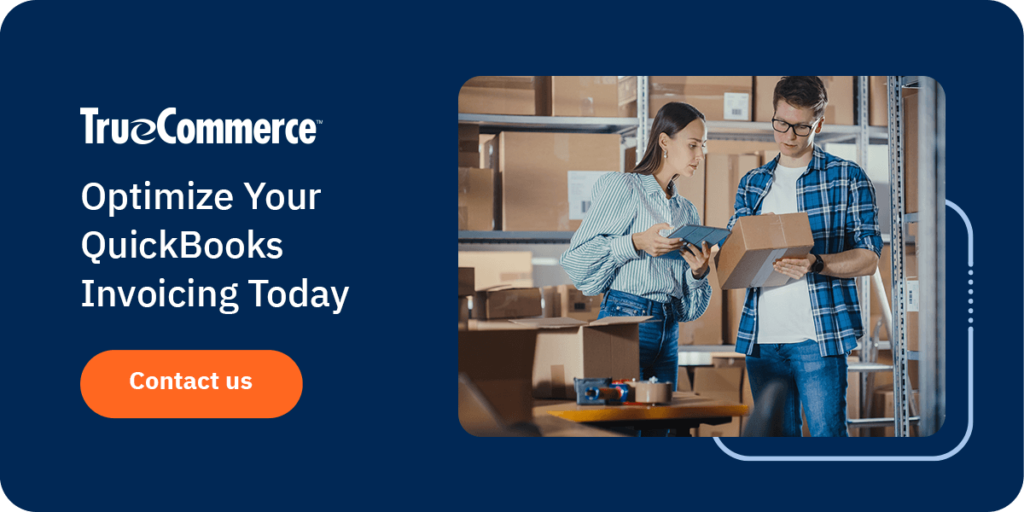How to Improve Your QuickBooks® Invoicing Process

January 16, 2024
For many businesses, invoicing is a slow and laborious process rife with manual data entry and errors. About 85% of respondents in one survey said they were still manually matching payments with remittances in 2022. These processes can significantly affect cash flow, the customer experience, and other aspects of your accounts receivable operations.
QuickBooks® offers some excellent invoicing tools, but integrations with your other business systems can dramatically speed up your process. If your goals include scalability, time savings, or reduced costs, improving QuickBooks invoicing is essential.
1. Automate Your Invoicing Process
One of the most valuable changes you can make to your QuickBooks invoicing is to automate it. Within QuickBooks, you can generate invoices and schedule them to be sent at certain times or recurring intervals. However, someone must still enter the relevant information into QuickBooks and choose a time to send the invoice. For more comprehensive automation, consider integrating QuickBooks with other business systems, such as an enterprise resource planning (ERP) program. You can also link it with your partners, such as third-party logistics (3PL) providers and suppliers.
These integrations offer seamless access to the data required to generate invoices and maximize value from them. Less manual entry means your team members can focus on higher-value tasks that grow the business and avoid the costs of human error, such as time, money, and reputational damage. Since your team doesn’t need to process invoices manually, your business can scale without increasing hiring demands. All these benefits translate to savings on your bottom line.
Some ways you can automate and streamline QuickBooks invoicing include:
- Processing inbound PDF invoices.
- Reconciling paid invoices within QuickBooks.
- Creating an automated approval workflow to reduce human oversight.
- Emailing customers their invoices and reminders for instant delivery.
- Integrating invoices with credit memos, purchase order (PO) numbers, and other supporting documents.
- Generating sales orders and invoices from inbound POs with electronic data interchange (EDI) codes 850/875.
- Building and sending outbound invoices with EDI codes 810/880.
- Connecting to 3PL providers and suppliers and using incoming data, such as POs and Warehouse Shipping Advice documents, to inform invoicing.
Two factors to look for in a QuickBooks automation solution are EDI capabilities and integrations with other business systems. They can streamline QuickBooks invoicing by incorporating data from inbound transactions and internal systems and correctly generating outbound transactions according to partner requirements.
2. Include the Right Information
The right information on an invoice helps recipients understand their payments and your policies, increasing the chances they’ll make on-time payments and supporting a fast order-to-cash cycle.
Here are some details to include:
- Business information, such as your name, address, and contact information
- Branding elements, such as a high-resolution logo and color scheme, to reinforce recognition
- Customer information, such as name, address, and contact details
- An invoice number for referencing and tracking the invoice
- Dates for when the invoice was created and when it’s due
- The total amount due and any taxes and fees
- Descriptions and quantities for items or services sold
- Unique fields associated with the items or services, such as PO numbers, job numbers, or proof of delivery documents
- Information on payment options, including methods available and how to make payments
- Information on late fees, return policies, and warranties
You may also want to include a brief message thanking the customer for their business.
3. Implement Error Reduction Tactics

Building process controls into your QuickBooks invoicing workflows can help prevent and identify errors, such as typos and duplicate entries. Process controls, such as those used in automation systems, confirm the accuracy of entered data and can flag any invalid fields before sending the invoice to the payer.
For example, TrueCommerce can verify that elements on incoming orders, such as unit prices, align with your QuickBooks data. These safeguards help reduce chargebacks and speed up order turnarounds while streamlining QuickBooks invoicing.
4. Use Templates
QuickBooks has robust template options, and using them well can speed up invoicing while promoting your brand and giving customers a better experience. Create templates for different customer groups, and tailor them to those customers’ needs.
For instance, your business partners could get invoices with PO numbers and payment information for conducting a bank transfer. Meanwhile, consumers wouldn’t need PO numbers and would likely prefer details on paying with a credit card. You could even change invoices based on the department or location the customer ordered from.
Customizing templates lets you target buyers and create a convenient and understandable payment process. In a survey from Salesforce, 80% of customers said the experience a company offers is as important as its services and products, but 61% of customers also think most companies treat them as a number. With templates for QuickBooks invoice optimization, you can offer a stellar experience without excessive administrative requirements, especially when combined with data collected from other systems.
5. Leverage Analytics and Reporting
QuickBooks offers some basic analytics tools, but you can access more advanced features by connecting QuickBooks to other business systems, such as an ERP system. ERP software excels at analyzing and reporting on diverse data sources but needs the right connections. By connecting an ERP platform to QuickBooks data and other sources of information, you can explore insights about your invoicing process.
For instance, you could watch the average invoice processing time or evaluate whether an early payment discount impacted cash flow. Invoicing metrics and reports can help you identify what works and areas of opportunity — information you’ll need to optimize your QuickBooks invoicing.
6. Consider Batch Invoicing
Batch invoicing speeds up the process of sending invoices to multiple customers. You can use it if you offer subscriptions or recurring services or have a project-based business with many partners involved. For example, you could use batches to bill entry fees to all conference attendees or request payment for monthly consulting services.
This process streamlines QuickBooks invoicing with certain business models by eliminating the need to create separate invoices for each customer.
7. Adjust Your Settings
Within QuickBooks, you can change some settings about how the program handles invoices, potentially eliminating some unnecessary steps.
Here’s how to change invoice preferences in QuickBooks:
- Go to the Settings page and head to the Preferences window. Select Sales & Invoicing.
- Under Estimates, you can choose “I want to create progress invoices from estimates” to create invoices throughout a project.
- Free on Board (FOB) represents where you typically ship invoiced products from. By updating the Usual FOB field to your location, QuickBooks can use that field in sales forms.
- Select your Usual Shipping Method to have QuickBooks automatically fill the Ship Via field on sales forms.
- Select “Automatically apply payments” to have QuickBooks automatically apply customer payments to their outstanding invoices.
- Select “Automatically calculate payments” if you want QuickBooks to check an invoice before calculating the total in the Amount Received field.
- Select “Warn about duplicate invoice numbers” if you want QuickBooks to check and notify you of any duplicates.
Optimize Your QuickBooks Invoicing Today

Slow, manual accounting processes can be costly for any business, but with the right strategies and systems, you can eliminate time-consuming data entry and allow your team members to work more efficiently. From completely automating your processes to using time-saving tools such as templates and analytics, you can streamline QuickBooks invoicing in the way that works for your organization.
If you’re interested in automating QuickBooks invoicing, TrueCommerce can help with integrations for business systems and a network of more than 180,000 companies, such as online retailers and nationwide stores. Learn more about automating and optimizing QuickBooks invoicing by booking a demo today!
Share this post:
Categories
Stay ahead of the competition
Get expert supply chain insights delivered directly to your inbox weekly.